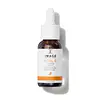What's inside
What's inside
 Key Ingredients
Key Ingredients

 Benefits
Benefits

 Concerns
Concerns

 Ingredients Side-by-side
Ingredients Side-by-side

Water
Skin ConditioningAscorbic Acid 23%
AntioxidantPropanediol
SolventDimethicone
EmollientTromethamine
BufferingPanthenol
Skin Conditioning3-O-Ethyl Ascorbic Acid
Skin ConditioningSqualane
EmollientCaffeine
Skin ConditioningSodium Chloride
MaskingSodium Hyaluronate
HumectantSodium Sulfite
PreservativeDisodium EDTA
Glutathione
Adenosine
Skin ConditioningAcetyl Glucosamine
Skin ConditioningGardenia Florida Fruit Extract
Skin ConditioningAllantoin
Skin ConditioningDextrin
AbsorbentTocotrienols
Skin ConditioningTocopherol
AntioxidantElaeis Guineensis Oil
EmollientButylene Glycol
HumectantArginine
MaskingNiacinamide
SmoothingPentylene Glycol
Skin ConditioningAlcohol Denat.
AntimicrobialHelianthus Annuus Seed Oil
EmollientGlycyrrhiza Glabra Root Extract
BleachingMethyl Trimethicone
Skin ConditioningCarthamus Tinctorius Seed Oil
MaskingCamellia Japonica Seed Oil
EmollientDaucus Carota Sativa Root Extract
Skin ConditioningBeta-Carotene
Skin ConditioningWater, Ascorbic Acid 23%, Propanediol, Dimethicone, Tromethamine, Panthenol, 3-O-Ethyl Ascorbic Acid, Squalane, Caffeine, Sodium Chloride, Sodium Hyaluronate, Sodium Sulfite, Disodium EDTA, Glutathione, Adenosine, Acetyl Glucosamine, Gardenia Florida Fruit Extract, Allantoin, Dextrin, Tocotrienols, Tocopherol, Elaeis Guineensis Oil, Butylene Glycol, Arginine, Niacinamide, Pentylene Glycol, Alcohol Denat., Helianthus Annuus Seed Oil, Glycyrrhiza Glabra Root Extract, Methyl Trimethicone, Carthamus Tinctorius Seed Oil, Camellia Japonica Seed Oil, Daucus Carota Sativa Root Extract, Beta-Carotene
Caprylic/Capric Triglyceride
MaskingSqualane
EmollientMoringa Oleifera Seed Oil
EmollientVitis Vinifera Seed Oil
EmollientHippophae Rhamnoides Fruit Oil
Skin ProtectingTetrahexyldecyl Ascorbate
AntioxidantCitrus Aurantium Dulcis Peel Oil
MaskingTocopheryl Acetate
AntioxidantRetinyl Palmitate
Skin ConditioningHelianthus Annuus Seed Oil
EmollientArgania Spinosa Kernel Oil
EmollientTocopherol
AntioxidantPersea Gratissima Oil
Skin ConditioningLimonene
PerfumingLinalool
PerfumingCaprylic/Capric Triglyceride, Squalane, Moringa Oleifera Seed Oil, Vitis Vinifera Seed Oil, Hippophae Rhamnoides Fruit Oil, Tetrahexyldecyl Ascorbate, Citrus Aurantium Dulcis Peel Oil, Tocopheryl Acetate, Retinyl Palmitate, Helianthus Annuus Seed Oil, Argania Spinosa Kernel Oil, Tocopherol, Persea Gratissima Oil, Limonene, Linalool
 Reviews
Reviews

Ingredients Explained
These ingredients are found in both products.
Ingredients higher up in an ingredient list are typically present in a larger amount.
Helianthus Annuus Seed Oil is the oil derived from the seeds of a Sunflower. Sunflower seed oil is non-fragrant. It is an emollient, meaning it helps to soften the skin.
Sunflower seed oil contains many fatty acids. The fatty acids found in sunflower seeds include (from highest amount to least): linoleic acid, myristic acid, palmitic acid, stearic acid, arachidic acid, oleic acid, and linolenic acid.
These fatty acids help the skin create ceramides. Ceramides play a role in repairing the skin barrier.
Helianthus Annuus Seed Oil helps moisturize the skin. This in turn helps the skin look more rejuvenated and smoother.
Sunflowers are rich in vitamin E.
Historians believe Indigenous cultures of North America domesticated sunflowers before corn. Thus they relied on sunflower oil for a variety of uses. One such use is moisturizing skin and hair.
Sunflower seed oil may not be fungal acne safe. We recommend speaking with a professional if you have any concerns.
Learn more about Helianthus Annuus Seed OilSqualane is an emollient that helps the skin hold onto moisture. It's an oily liquid that occurs naturally in certain types of fish and plant oils.
Because squalane boosts hydration in the skin, it also comes with plenty of benefits: it is an antioxidant and can help fight free radicals and skin damage. Squalane is also found to have a detoxifying effect when applied.
Squalane comes from squalene, which occurs naturally within the sebum of our skin. It is one of the oils our skin produces to keep itself hydrated. Squalane is the hydrogenated version of squalene and has a longer shelf life.
Research shows that squalane is non-irritating (even at 100% concentration).
In general, it's a fantastic ingredient. It does a great job at hydrating the skin, and it's suitable for those with sensitive skin.
The source of squalane may impact malassezia / fungal acne. This is because olive oil derived squalane can contain impurities such as fatty acids and plant waxes. Sugarcane derived squalane is recommended for anyone with malassezia concerns.
Is squalane vegan?
This depends on the source. Squalane can be derived from both plants and animals. Most squalane used in skincare comes from plants.
Please note: the source of squalane is only known if disclosed by the brand. We recommend reaching out to the brand if you have any questions about their squalane.
Read more about squalene with an "e".
Is squalane an oil?
Squalane is often called an oil, but it’s technically not; it’s a hydrocarbon, meaning it’s only made of carbon and hydrogen, unlike true oils which are triglycerides made of fatty acids and glycerol.
The term “oil-free” isn’t regulated, so companies can define it however they want. Some exclude all oils, while others just avoid mineral oil or comedogenic oils.
While some people avoid oils thinking they cause breakouts, the right kind of oil (or oil-like ingredient like squalane) can actually help balance and hydrate your skin. It’s worth testing out simple oils or squalane to see what works best for your skin.
Learn more about SqualaneTocopherol (also known as Vitamin E) is a common antioxidant used to help protect the skin from free-radicals and strengthen the skin barrier. It's also fat soluble - this means our skin is great at absorbing it.
Vitamin E also helps keep your natural skin lipids healthy. Your lipid skin barrier naturally consists of lipids, ceramides, and fatty acids. Vitamin E offers extra protection for your skin’s lipid barrier, keeping your skin healthy and nourished.
Another benefit is a bit of UV protection. Vitamin E helps reduce the damage caused by UVB rays. (It should not replace your sunscreen). Combining it with Vitamin C can decrease sunburned cells and hyperpigmentation after UV exposure.
You might have noticed Vitamin E + C often paired together. This is because it is great at stabilizing Vitamin C. Using the two together helps increase the effectiveness of both ingredients.
There are often claims that Vitamin E can reduce/prevent scarring, but these claims haven't been confirmed by scientific research.
Learn more about Tocopherol